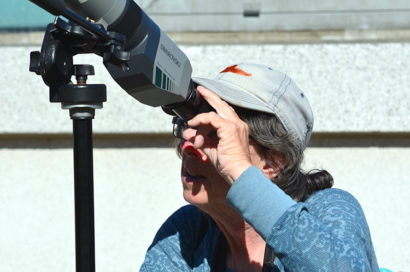Campanile peregrine falcon chicks could hatch any day
The Campanile’s resident peregrine falcon couple could become the lucky parents of new chicks on the biggest day of the year at UC Berkeley
April 19, 2018
The Campanile’s resident peregrine falcon couple could become the lucky parents of new chicks on the biggest day of the year at UC Berkeley: Cal Day (Saturday, April 21).

It was discovered the peregrine chicks had hatched last year when the female was seen bringing back a dead pigeon to the nest site. This year, the chicks might hatch on Cal Day. (Photo by Mary Malec)
Each year, tens of thousands of visitors flock to the campus for the annual open house, and this year, they can stop by a falcon viewing station at the southwest corner of Evans Hall from 9 a.m. to noon to catch a glimpse of the falcons perched on the ledge or circling the 307-foot bell tower.
If the chicks do hatch on Saturday, they won’t be visible from the ground. But there is a way to tell if they’ve hatched: The parents start bringing food back to the nest site.
Peregrines, which reach speeds of more than 200 miles per hour, kill their prey, usually other birds, in mid-air. The Campanile, with its great views and ample supply of pigeons to eat, is prime real estate for the peregrines, says Mary Malec, a volunteer raptor coordinator with the East Bay Regional Park District.
The peregrine pair first made the Campanile their home last year, with two chicks hatching in late May. The chicks were named Fiat and Lux by the campus community in a Facebook survey.
Last year, Malec coordinated a group of volunteers who watched the fledglings around the clock to make sure they had a safe first flight. She plans to do the same this year when the nestlings fledge about 38 to 42 days after they hatch.
Crowds don’t seem to bother the peregrines, says Malec, so Cal Day visitors can still take rides up in the elevator to the Campanile’s observation deck. (The nest site isn’t visible from the deck.) The male peregrine tends to avoid crowds, however, so he might steer clear of the tower until they disperse.
“If babies hatch and he’s not there to bring in food,” says Malec, “they can go for a day after hatching without eating. The female keeps food stashed around the nest area and can go get it if she needs to feed them.”
Once on the brink of extinction, peregrine falcons have made a remarkable comeback in the past few decades, and begun moving from their natural cliff faces into urban areas, laying their eggs on skyscrapers and other tall buildings. They are still a fully protected species in California.
In order to not disturb the peregrines, Malec hasn’t gone up to see how many eggs are in the nest box. But once the chicks hatch, experts will set up a time to band the chicks. It’s scheduled tentatively for May 11.
Read more about the Campanile’s peregrine falcons:
- Cal’s main attraction? For nesting peregrines, it’s the Campanile
- Peregrine falcon chicks on Campanile now banded, getting ready to fly
- With Campanile’s peregrine chicks ready to fly, volunteers ready to help
- Peregrine fledgling takes its first plunge of the Campanile
- Baby peregrine Falcon Lux hits window on campus, dies
- Bird-safe streamers in place, peregrine falcon Fiat to leave any day
- Campanile peregrine falcons coupling up again, with a new nest box


